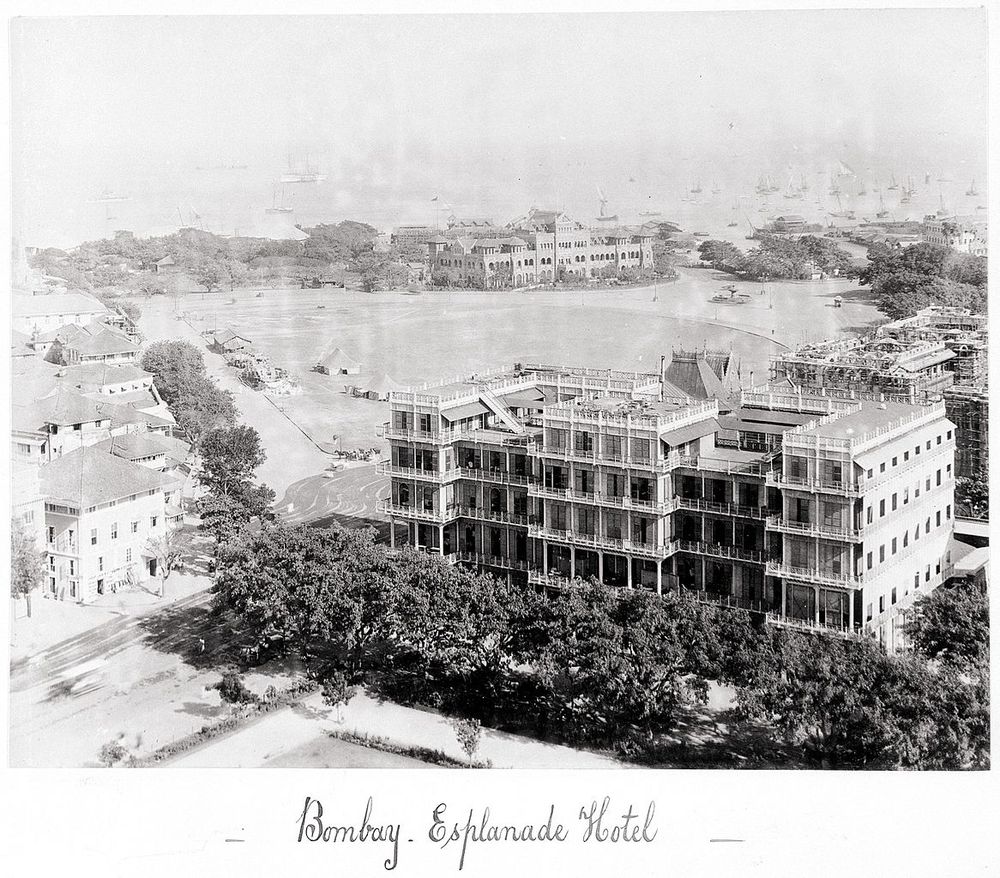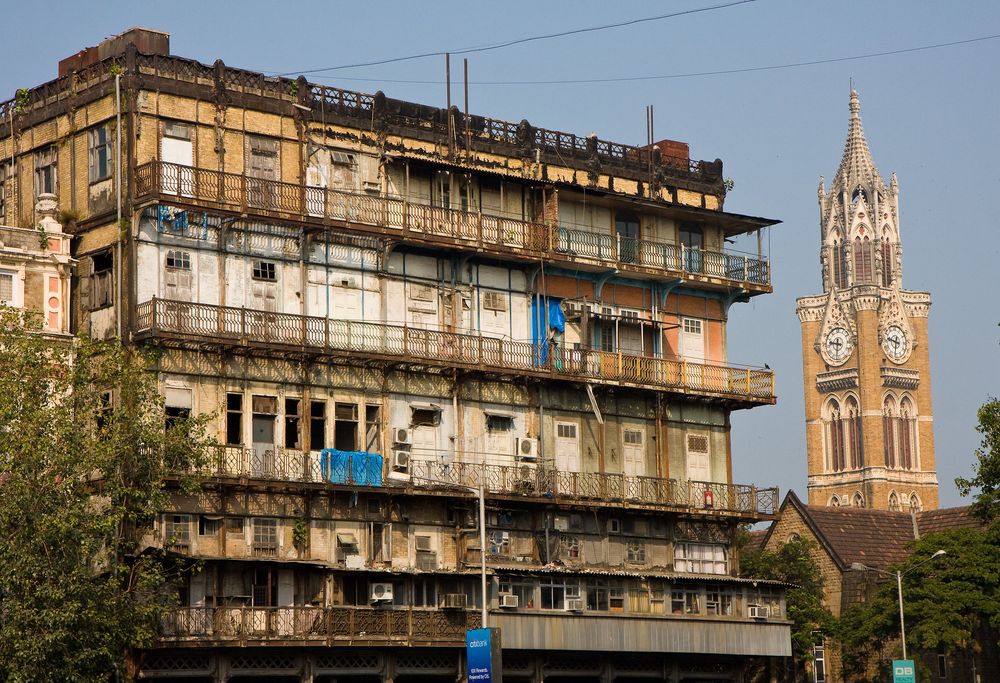Early one morning In 1867, a traveler walking through the familiar streets of Kala Ghoda district in Bombay noticed something strange “like a huge birdcage had risen like an exhalation from the earth.” The birdcage was the skeleton of the Watson’s Hotel, later to be called Esplanade Mansion, India’s oldest surviving cast iron building and one of the few in the world. When it was completed in 1869, it was heralded as one of the finest examples of cast-iron architecture in the world.

Watson’s Hotel now knows as Esplanade Mansion in 2008. Photo: Ben Lepley/Flickr
Watson’s Hotel was named after its first owner, John Hudson Watson, a successful cloth merchant in Bombay, who had, in 1864, bought land in South Bombay with the intention of erecting a building for office space and showrooms for his flourishing drapery and tailoring business in the city. However, he changed his plans and decided to open a luxury hotel instead. Probably influenced by the evolving use of cast iron in architecture in Europe and America, Watson chose a minimalist iron framework in a neighbourhood replete with turrets, gabled roofs, stones and arches.
Along with the designs submitted to the government for approval, there was a letter that informed:
The building is intended to be done in wrought and cast iron with brick on rubble wall foundations, Moranjee hill stone plinths, and brick party walls. The structure above the plinth with the exception of the party walls will be formed with cast iron columns and wrought iron riveted girders and a wrought iron double roof. The plain portions of the faces will be wrought iron and the ornamental portions will be executed in cast iron. The joists and floors will be of teak and the building will be lined with hollow bricks set in cement. The partitions inside will also be hollow bricks.
The building was fabricated in England and its components shipped to India, where it was assembled on site between 1867 and 1869. The hotel was designed by the civil engineer Rowland Mason Ordish, best known for his work on the Crystal Palace in London in 1850, the Winter Garden in Dublin, Cavenagh Bridge in Singapore, Albert Bridge in London and a number of cast and wrought-iron structures such as bridges and market halls.

The original design included traditional European mansard roof, however it was built as a simplified flat roofed form.
When the hotel opened in 1871, the Bombay Gazette declared it to be "without a doubt the finest hotel in Bombay". In those days, the few small hotels and taverns around Bombay were lacking in amnesties and ill-equipped for the European travelers. Watson gave his hotel the Western aesthetic. The five-storied structure had 130 rooms for guests with attached bathrooms, a lobby, a restaurant serving exquisite European cuisine, a large ballroom with a glass skylight, and an entertainment room equipped with a pool table. The hotel was installed with India’s first steam-powered elevator, and each occupied room was appointed a punkah wallah—a native who would manually operate the fans. These men were probably replaced with electrically driven ceiling fans when electricity was introduced in the country in 1879. Because Watson’s Hotel catered exclusively to Western guests, the hotel employed only English waitresses in its restaurant and ballroom, inspiring a common joke at the time: “If only Watson had imported the English weather as well.”
Watson’s Hotel was the most premier hotel in Bombay and conveniently located near the harbor as well as the railway station. “Whomsoever was a person of importance, passed through Bombay and planned to stay overnight, would prefer to stay here," says Rajan Jayakar, convener of the Greater Mumbai chapter of INTACH (Indian National Trust for Art and Cultural Heritage).

The Watson’s Hotel shortly after it was completed.
When Mark Twain visited Mumbai in 1896, he stayed at Watson’s Hotel. Later, in his book Following the Equator: A Journey Around the World, Twain describes the service provided at the establishment:
In the dining-room every man's own private native servant standing behind his chair, and dressed for a part in the Arabian Nights. Our rooms were high up, on the front. A white man—he was a burly German—went up with us, and brought three natives along to see to arranging things. About fourteen others followed in procession, with the hand-baggage; each carried an article—and only one; a bag, in some cases, in other cases less. One strong native carried my overcoat, another a parasol, another a box of cigars, another a novel, and the last man in the procession had no load but a fan. It was all done with earnestness and sincerity, there was not a smile in the procession from the head of it to the tail of it.
Watson’s Hotel was the place where the first movie screening occurred in India. It was one of seven venues where the Lumiere brothers screened their films while on a world tour of their moving pictures. The screening here took place on 7th July 1896.
According to one legend, India’s pioneering industrialist Jamsetji Tata was once denied entrance to the Watson’s Hotel, since he was a coloured man. Humiliated, Tata vowed to build a hotel far grander and majestic that the one that had rejected him. While there is no historical evidence supporting this incident, Tata did establish the Taj Mahal Palace Hotel in Bombay, a short distance away from Watson’s Hotel. It opened its door to the public in 1903, and soon became one of Watson's Hotel's greatest competitors.

Watson’s Hotel in a dilapidated state. Photo: Garrett Ziegler/Flickr
It is said that the Taj Mahal Hotel eventually ended Watson’s Hotel’s coveted status and within two decades, Watson’s ceased to be a hotel. The building was temporarily bought by the Maharaja of Morvi, before being purchased by the Tatas in 1944, when it was renamed Esplanade Mansion. In the 1960s, the building was partitioned into small cubicles and rented out to housing and offices.
Over the years, apathy toward the building by the occupants and owners has caused the building to decay. Today, the once glorious structure is in seriously dilapidated state. In 2005, part of the cast iron structure broke off killing one person. Subsequently, the Maharashtra Housing and Area Development Authority (MHADA) declared the building unsafe. Nevertheless, the tenants, refused to evacuate. After a prolonged delay, the tenants consented to phased repair. But no sooner restoration project got underway, the tenants argued that that the interventions were damaging the historic fabric of the building, and the project was halted. At the time of this writing, the courts are still undecided who should undertake the restoration work and how the job is to be carried out.

Watson’s Hotel in a dilapidated state. Photo: Ben Lepley/Flickr
References:
# “The finest hotel in Bombay” now lies in a shambles, CN Traveler
# India’s Most Fragile World Heritage Building, Live History India
# Like a huge birdcage exhaled from the earth: Watson's Esplanade Hotel, Mumbai (1867-71), and its place in structural history., Construction History (Vol 18)












Comments
Post a Comment